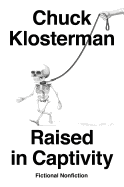
| Publisher: | Penguin Press | |
| Genre: | Short Stories (single author), Fiction | |
| ISBN: | 9780735217928 | |
| Pub Date: | July 2019 | |
| Price: | $26 |
| Starred | Fiction |
by Chuck Klosterman
In Raised in Captivity, beloved essayist Chuck Klosterman offers a collection of stories that may not be true but feel genuine all the same. As the book's playful subtitle--"fictional nonfiction"--suggests, these short works are at once utterly absurd and eerily familiar. Whether it's two airplane passengers discussing their obligation to disclose the presence of a wild puma in the lavatory, or an assassin who requires four years to kill his targets, Klosterman's characters are arguably at their best when they're serving as proxies for the author himself.
Like the essays in his numerous bestselling collections, many of the stories here serve as meta-commentary on elements of culture and the collective psyche. Klosterman's acclaim as one of the best pop culture critics working today is largely based on his ability to wrest profound meaning from the seemingly mundane, be it a 1988 high school basketball game that occurred in North Dakota or the intrinsic value of a Guns 'N Roses cover band. While he does have two novels to his name, Raised in Captivity is Klosterman's first official foray into short fiction (clever subtitles aside).
In a sense, these aren't stories where anything happens per se, but rather a series of fictional frameworks through which Klosterman is able to examine the madness and minutiae of everyday lives. He isn't prone to definitive conclusions, but Klosterman thrives within the auspices of the unknown, making this collection a worthy addition to his peculiar and impressive legacy. --Zack Ruskin, freelance reviewer

| Publisher: | Graywolf | |
| Genre: | Literary, Fiction | |
| ISBN: | 9781555978457 | |
| Pub Date: | July 2019 | |
| Price: | $15 |
| Starred | Fiction |
by Selva Almada, trans. by Chris Andrews
A broken-down car on a rural Argentinian road brings together two unlikely father-and-teen pairs. Reverend Pearson should have listened to daughter Leni's warnings about their overused jalopy, but its failure lands them in the garage of El Gringo Brauer and his assistant, Tapioca. Pearson considers the unplanned stopover yet another opportunity to preach, but after an initial offer of cold drinks, Brauer quickly withdraws to resurrect Pearson's stalled car. While Leni watches warily, Tapioca just might be willing to listen.
The hot, dusty afternoon progresses, until the brewing storm finally arrives. The foursome are forced inside in close quarters, to share a meal, conversation, something of their very selves. They temporarily re-pair: the teens to play games, the men drinking and talking. But Pearson won't relinquish a potentially savable soul, and somehow he's asking to take Tapioca away from Brauer. Tempers flare, desperation sparks violence and the children become pawns in a showdown for control.
Originally published in 2012, garnering international attention and translated into multiple languages, Selva Almada's first novel, El viento que arrasa, arrives in the U.S. as The Wind That Lays Waste, smoothly translated by Australian Chris Andrews, who was the first to render Roberto Bolaño's work into English. As Almada tautly reveals the events of a single day during which four disparate lives briefly intersect, she deftly interweaves the pivotal details about each of the quartet (Leni's missing mother, Tapioca's abandonment, Brauer's failures, Pearson's self-delusions) that contribute to the final implosion. English-reading audiences can expect a dynamic introduction to a major Latin American literary force. --Terry Hong, Smithsonian BookDragon
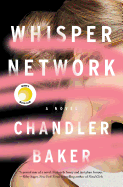
| Publisher: | Flatiron | |
| Genre: | Women, Psychological, Domestic, Thrillers, Fiction | |
| ISBN: | 9781250319470 | |
| Pub Date: | July 2019 | |
| Price: | $26.99 |
| Fiction |
by Chandler Baker
Chandler Baker's Whisper Network starts with eyewitnesses saying what looked like "a giant bird" fell out of the sky. It wasn't a bird but a man, who wasn't super at all. Instead of leaping a tall building in a single bound, he appeared to have just leapt to his death.
The story backtracks to two months earlier, to the day the CEO of Truviv Inc. dies of a heart attack. All indicators point to the man's successor being Ames Garrett, the company's general counsel. Sloane, Ardie and Grace, all lawyers who report to Ames, find this unacceptable. They participate with other professional women in a whisper network, which includes disseminating a BAD Men spreadsheet--the acronym stands for Beware of Assholes in Dallas.
After suffering years of inappropriate behavior from Ames, Sloane puts his name on the spreadsheet. She and her friends make other moves to keep Ames from becoming CEO. Their actions cause a chain reaction, leading up to--but not ending with--that day the body fell out of the sky.
Women everywhere who have ever worked with toxic men might get neck cramps while reading Whisper Network, from nodding fervently at all the truth bombs Baker drops. Take this observation: "Believe it or not, we didn't want to be offended. We weren't sitting around twiddling our thumbs waiting for someone to show up and offend us so that we would have something to do that day." The social commentary is razor sharp and incisive in its wit, and readers will be loud and clear when recommending this novel. --Elyse Dinh-McCrillis, blogger at Pop Culture Nerd
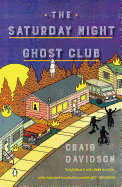
| Publisher: | Penguin Books | |
| Genre: | Small Town & Rural, Ghost, Literary, Coming of Age, Fiction | |
| ISBN: | 9780143133933 | |
| Pub Date: | July 2019 | |
| Price: | $16 |
| Fiction |
by Craig Davidson
Craig Davidson (Rust and Bone) harnesses the appeal of campfire tales in his coming-of-age story The Saturday Night Ghost Club. Jake Baker remembers the summer he was 12, when he believed in monsters and adult benevolence--and discovered both were purely imaginary.
Jake lives in Niagara Falls, Ontario, where the magnificent Falls loom over seedy tourist traps. His Uncle Calvin owns the Occultorium, a store that attracts tourists as well as local kids eager to be a little scared. Jake himself is easily frightened, but when Calvin tells him and his two friends, "There are places I know... where the barriers between our world and the spirit realm are full of holes," they gamely join his "Saturday Night Ghost Club." The club breaks into a mortuary, investigates the site of a deadly house fire and creeps into haunted tunnels. Calvin's nighttime adventures, however, aren't as random as they seem. Jake learns the sobering truth that evil is a human trait, not ghostly, displayed by those who are "circling the burning fires of civilization, waiting for us to step away from the light."
Davidson also writes horror novels under the pseudonym Nick Cutter, explaining his adroit handling of the ghostly events. This novel presents what adults know full well: life's deepest fears have little to do with conventional horror and everything to do with love and loss. This compact novel is reminiscent of Ray Bradbury's Dandelion Wine and Stephen King's The Body: dark and unforgettable coming-of-age stories. --Cindy Pauldine, bookseller, the river's end bookstore, Oswego, N.Y.
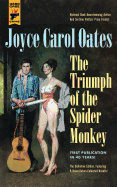
| Publisher: | Hard Case Crime | |
| Genre: | Mystery & Detective, Crime, General, Literary, Fiction | |
| ISBN: | 9781785656774 | |
| Pub Date: | July 2019 | |
| Price: | $9.95 |
| Mystery & Thriller |
by Joyce Carol Oates
Originally published in 1976, Joyce Carol Oates's The Triumph of the Spider Monkey reveals the mind of a serial killer in the aftermath of his capture. Bobbie Gotteson, abandoned in a bus station as an infant, grew up in foster care, persistently and systematically abused by almost everyone he encountered. Now, after having been convicted of hacking to death nine stewardesses, Gotteson retraces the steps of his miserable life as a wannabe entertainer and ladies' man, up through his final attack. In this reprint, the novel is paired with the novella "Love, Careless Love," which focuses on a down-and-out detective who becomes slowly and violently obsessed with the lone survivor of Gotteson's attack.
The definition of an unreliable narrator, Gotteson drags the reader into his consciousness, starting from the moment of his own imagined infancy, a corrupted version of a hero's origin story that shows him being birthed from a bus station locker. His reality is a fragmented, sweaty, clamorous, paranoid fantasy and Oates's frenetic prose brings a new understanding to the concept of mania. The women who slip in and out of Gotteson's life and subconscious guide his story, despite his insistence that he hates them. These women--who are depicted by Gotteson as every conceivable female stereotype from virgin mother to sexual trash--fight against the confines of Gotteson's perspective. Meanwhile, the anxious, neon-lit world of '60s and '70s American culture eggs them all on, urging the novel's characters toward one bloody climax after another. The accompanying novella continues the novel's exploration of a world turned nightmare because of capitalist misogyny by delving into the viciousness inherent in even a seemingly ordinary man. --Alice Martin, freelance writer and editor

| Publisher: | Little, Brown | |
| Genre: | Psychological, Crime, Suspense, Thrillers, Fiction | |
| ISBN: | 9780316490146 | |
| Pub Date: | July 2019 | |
| Price: | $28 |
| Mystery & Thriller |
by Guillaume Musso, trans. by Frank Wynne
On the surface, Thomas Degalais is a success. He's an author with several respected novels, enough to support a comfortable life in Manhattan. He is the product of the Saint Ex, an elite French school on the Côte d'Azur. When Thomas receives an invitation to attend the school's 50th anniversary and celebrate the groundbreaking of a new building, he accepts without question--but not to catch up with old classmates. Saint Ex was "far from being a lost paradise"; instead, it was "the setting of a tragedy [he] had been running from" for 25 years.
Vinca Rockwell was an American student who bewitched Thomas when they were students in the early '90s. But her allure also drew others, so when Vinca disappeared at the same time as philosophy professor Alexis Clément, everyone assumed the two ran away together. Thomas and classmates Maxime and Fanny knew the truth: Thomas killed Alexis, believing he was abusing Vinca, and buried him in the walls of the gym that's about to be torn down. And with fellow classmate Stéphane Pianelli, a journalist with a chip on his shoulder, looking to solve the decades-old mystery, Thomas's world is closing in on him.
The Reunion is a multi-layered thriller that's fueled by urgency and drama, and Guillaume Musso adds a menacing quality to the glamorous Côte d'Azur. With plot twists unleashed at a furious pace, The Reunion is a nightmare set in privileged utopia. --Frank Brasile, librarian
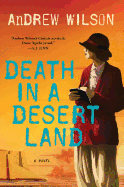
| Publisher: | Washington Square Press/Atria | |
| Genre: | Mystery & Detective, Ancient, General, Fiction, Historical, Women Sleuths | |
| ISBN: | 9781501197444 | |
| Pub Date: | July 2019 | |
| Price: | $28 |
| Mystery & Thriller |
by Andrew Wilson
On the heels of her divorce, Agatha Christie is in need of a change. An old British Intelligence Officer friend asks for her help in determining whether the death of Gertrude Bell, famed archeologist and explorer, was a suicide, an accident or murder, sending Christie off to Iran and an archeological excavation that could be under a terrible curse. Going undercover, infiltrating the motley crew at the dig site while keeping her real reason for being there a secret, Christie attempts to make sense of the complicated existing relationships and tensions while trying to solve one alleged murder and prevent another one (or more!) from occurring.
Providing a fascinating glimpse into the lives of real people doing actual excavation work in the city of Ur in 1928, Death in a Desert Land is Andrew Wilson's third book in this series, following A Talent for Murder and A Different Kind of Evil, yet can be read as a standalone mystery. An intriguing cast of characters provides insight into the hierarchical roles, racial and gender prejudices and established modes of 1920s behavior, while the desert landscape is almost a character in its own right, by turns menacing and beautiful.
While there is no doubt Christie will find the answers, the quick pace of the plot, the severe environment and general mood of the circumstances--on top of Christie's sensitivity to heat (including both the sun and the potential attentions of a male photographer at the dig)--creates a dramatic tension that quickly builds to a satisfying conclusion. --BrocheAroe Fabian, owner, River Dog Book Co., Beaver Dam, Wis.

| Publisher: | Berkley | |
| Genre: | Women, Romance, Contemporary, Multicultural & Interracial, Fiction | |
| ISBN: | 9781984802194 | |
| Pub Date: | July 2019 | |
| Price: | $15 |
| Romance |
by Jasmine Guillory
In her first novel, The Wedding Date, Jasmine Guillory introduced Alexa, an attorney who works for the mayor of Berkeley, Calif. Alexa has two best friends: Theo, who works with her in the mayor's office, and Maddie, a stylist she's known since childhood. The problem is that Maddie and Theo hate each other. But for the sake of Alexa, they've muddled along.
One night, a little too much to drink at a party accidentally leads to a sexy night together, and Maddie and Theo realize that they're very physically compatible. But Maddie still thinks Theo is uptight, and he still finds her frivolous. When Alexa gets engaged and asks Maddie and Theo to be her bridesmaid and "bridesman," they realize they're going to have to spend a lot of time together. So they decide to have a fling, no strings attached, that will end as soon as the wedding is over. As they accompany Alexa for cake testing and wedding dress shopping, they keep sneaking off to be together. But they're convinced that since they don't actually like each other, they can't tell Alexa, and they can't be together permanently. Or can they?
Jasmine Guillory has nailed the sexy but quarrelsome tension between Maddie and Theo. Effervescent and smart, The Wedding Party is a romance for people who think they don't like romances. Cameos by other characters from The Wedding Date and The Proposal make The Wedding Party shine, as does the diverse cast of characters and the witty dialogue. --Jessica Howard, bookseller at Bookmans, Tucson, Ariz.

| Publisher: | Grove Press | |
| Genre: | Literary Collections, Essays | |
| ISBN: | 9780802129093 | |
| Pub Date: | June 2019 | |
| Price: | $23 |
| Essays & Criticism |
by Kathleen Hale
Some autobiographical writers can get by on voice alone. Others may get away with unspectacular prose if they have scintillating content. Then there's Kathleen Hale: each piece in her six-essay collection Kathleen Hale Is a Crazy Stalker succeeds as both a paragon of writerly execution and a crackerjack story.
In "Catfish," which has sparked considerable controversy since it ran in the Guardian in 2014, Hale goes in search of the true identity of a blogger who has been writing vicious things about her young adult novel. It's an episode that she regrets as "a sort of personal rock bottom" and that precipitated her stay at a psychiatric facility. In "Prey," she recalls her sexual assault by a man she was led to believe was her masseur and describes her role in his subsequent trial. There are several forays into immersion journalism. For one: in "Snowflake," Hale, as the houseguest of a woman in Snowflake, Ariz., who is suffering from what's known as environmental illness, must go fragrance-free and otherwise observe the "local logic" of a beset community.
Linking these disparate pieces are a steady stream of self-criticism, a fixation on animal nature and a preoccupation with ethics, including journalistic ("I wasn't convinced that our chemical odors would kill Snowflake's residents. But our narrative about them might"). Regarding ethics: Hale does things in these essays that the reader may not like--"Catfish" in particular may unnerve some. However, it's hard to be mad at a person who seems so mad at herself. --Nell Beram, author and freelance writer

| Publisher: | Tim Duggan | |
| Genre: | Biography & Autobiography, Travel, Cooking, Individual Chefs & Restaurants, Culinary, Essays & Travelogues | |
| ISBN: | 9781524759643 | |
| Pub Date: | July 2019 | |
| Price: | $26 |
| Travel Literature |
by Jeff Gordinier
Amidst the disintegration of his marriage, at the edge of the Caribbean and nearing exhaustion, Jeff Gordinier awoke with a mouthful of sand. This is the unlikely first taste in Hungry: Eating, Road-Tripping, and Risking It All with the Greatest Chef in the World.
Gordinier was on that beach at the behest of René Redzepi--perhaps the best chef in the world. Hungry chronicles what follows, as Gordinier spends the next four years orbiting Redzepi's world-class inner circle in this biographical travelogue.
Constant innovation marks Redzepi's approach to both his cooking and career. His Copenhagen restaurant, Noma, is often called the best in the world. But at the height of its success, Redzepi got bored and closed it to open pop-up restaurants in Japan, Australia and Mexico. Restless again, he then reinvented and reopened Noma.
Gordinier is a consummate food writer. His descriptions offer a poetic magnifying glass on flavors and experiences unattainable for most--tantalizing, tortuous. (Perhaps none will be more tortured than Gordinier's New York Times colleague Grant Gold, who overslept and missed most of his meal at Noma, as Gordinier delightfully gloats no fewer than a dozen times.)
Like Redzepi, Gordinier goes all in, nose to tail--and the ugly parts, of course, are the tastiest. Hungry is at its best as Gordinier observes Redzepi's insatiable mind at work, bent on change and adaptation, evoking emotions that crash in as flavors, bursting forth, inspiring reverence, awe and hunger. --Katie Weed, freelance writer and reviewer

| Publisher: | Hyperion | |
| Genre: | Humorous Stories, Animals, School & Education, Birds, Social Themes, New Experience, Juvenile Fiction | |
| ISBN: | 9781368046459 | |
| Pub Date: | July 2019 | |
| Price: | $16.99 |
| Children's & Young Adult |
by Mo Willems
Yes, that's the "Hallelujah Chorus" you hear. You're hearing it because there's a new Pigeon book from Mo Willems.
As The Pigeon HAS to Go to School! begins, the bird is tearing out its feathers. The Pigeon believes that school is totally unnecessary ("I already know EVERYTHING!"). The Pigeon worries about getting a pigeon hater for a teacher. The Pigeon--and here both the bird and the accompanying text grow tiny--is "scared." Following some bloodletting ("What if there is MATH? Or numbers?"; "Why does the alphabet have so many LETTERS?!"), the Pigeon seizes on an idea: "THERE SHOULD BE A PLACE TO PRACTICE THOSE THINGS!!!" Cue a light bulb over the bird's head: "Oh! That is school."
When Willems's Don't Let the Pigeon Drive the Bus! appeared in 2003, it was a shot heard round the picture book world. Its surface accessibility--easy-to-read text via dialogue bubbles; cartoonish renderings of a pigeon set against solid screens in Necco wafer colors--belied a fresh premise that kept readers on high alert: the Pigeon's hilariously hammy spiel seemed to be directed at them. The Pigeon HAS to Go to School! has all this and also addresses a common source of kid (and adult) anxiety: fear of the unknown.
A note to purists for whom the sequel will never be as good as the original: a certain vehicle makes a cameo after the Pigeon realizes that school may be worth a try ("Well, HOW am I supposed to get there, anyway!?!"). --Nell Beram, freelance writer and YA author
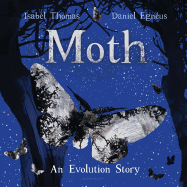
| Publisher: | Bloomsbury | |
| Genre: | Environmental Science & Ecosystems, Animals, Environmental Conservation & Protection, Zoology, Science & Nature, Butterflies, Moths & Caterpillars, Juvenile Nonfiction | |
| ISBN: | 9781547600205 | |
| Pub Date: | June 2019 | |
| Price: | $18.99 |
| Starred | Children's & Young Adult |
by Isabel Thomas, illust. by Daniel Egnéus
Isabel Thomas and Daniel Egnéus's Moth, about the transformation of the peppered moth (Biston betularia), is endowed with such a sense of wonder, the evolution story is almost elevated to the realm of myth.
It all begins "with a little moth... waking up from a long winter's sleep." "Hungry predators" lurk nearby--the moth flies away, joining other moths trying "not to get eaten." Most have "speckled, freckled wings," although there are a small number born with "wings as dark as charcoal." As the sun rises, the salt and pepper moths blend into the trees, but the charcoal ones stand out. Thomas's poetic yet pragmatic text asks, "Who was the best hidden? Who would survive?" Because the speckled moths have the best camouflage, they're the ones with the highest survival rate. Until the world changes. With the arrival of the Industrial Revolution, the air fills with "smoke and soot." In this "darker" world, the "darkest" moths, with their "charcoal-colored wings," now live long enough to pass on their wing color to offspring--until things change again. Cities begin to green up their acts. "Year by year by year," the air becomes cleaner and "trees shed their sooty bark." The "speckled, freckled" moths can once again blend in, and "today, both colors of moth find places to hide and survive."
Combining watercolors, crayon, acrylics, collage and Photoshop, Egnéus creates stunning visuals that feel soft and organic, yet also intricate and precise. Creative use of color, light and shadow, in addition to intriguing textures and bold shapes, make each spread fascinating to behold. Back matter condenses the evolution of the peppered moth into two pages of historical facts. Moth is a deeply fulfilling look at the ups and downs of natural selection. --Lynn Becker, blogger and host of Book Talk, a monthly online discussion of children's books for SCBWI
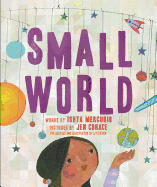
| Publisher: | Abrams | |
| Genre: | Concepts, Astronauts & Space, Technology, Girls & Women, Size & Shape, Juvenile Fiction | |
| ISBN: | 9781419734076 | |
| Pub Date: | July 2019 | |
| Price: | $17.99 |
| Children's & Young Adult |
by Ishta Mercurio, illust. by Jen Corace
When Nanda is young, "the whole" of her world is composed of comforting circles. Just after she's born, this means being "wrapped in the circle of her mother's arms"; as a toddler, the meaning expands to include "the circle of her loving family." It's not long before Nanda's world encompasses other shapes as well. Nanda gets "bigger and bigger," and her world grows with her. It opens up to include "a sway of branches" and "scaffolds of steel." It continues to increase in size as she rides a train from the "sun-kissed maze of wheat" near her hometown to the "symphony of glass and stone" that defines her college years.
Nanda's lifelong love of science "spool[s] through spirals of wire and foam" at school, yet Nanda and her world continue to grow. As Nanda gets "bigger and bigger and BIGGER," her world becomes "the roar of twin engines, a glittering ocean far below, and the curve of the planet beneath her."
Mercurio's gorgeously poetic text effortlessly balances the wonders of the natural world with the wonders created by scientists and engineers. Her repeating refrain as Nanda gets bigger ensures that this story is comforting to its youngest readers, while including enough variation to inspire older ones. Corace's gouache, ink and pencil spreads are always warm and bright, anchored by geometric shapes and patterns. An author's endnote says that the inspiration for this story came from a photograph taken at the Indian Space Research Organization showing five women "celebrating after they had helped put a satellite into orbit around Mars." Small World, like that photograph, depicts the joy there is to be found when young girls and women "all over the world" follow their dreams. --Lynn Becker, blogger and host of Book Talk, a monthly online discussion of children's books for SCBWI